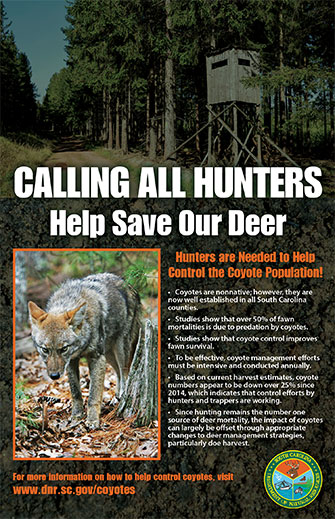Hunters: Help Control Coyotes and Save Our Deer!

Coyotes first appeared in SC about 45 years ago and can be found in all 46 counties. Coyotes are negatively impacting our official State Animal, the White-tailed deer, by preying heavily on deer fawns.
Since 2002, the SC deer population has declined by more than 30%. While our deer population is still healthy, we do not want to see it decline further.
The Coyote Facts
- Average adult coyote is 35 pounds, but can exceed 50 pounds.
- Coyotes are mostly grayish-brown to reddish-tan; nearly all black is not uncommon.
- Coyotes reproduce in late winter, have a 63-day gestation period, and produce 5-7 pups per litter.
- As evidenced in other states with long established coyote populations, expanding coyote populations are likely to impact local deer and small game. However, overtime coyote populations are expected to stabilize allowing deer, turkey and small game to still exist in healthy numbers in South Carolina.
Where did they come from?
- The South Carolina Department of Natural Resources has NEVER imported and released coyotes into the state for any reason, including deer management.
- Coyotes first appeared in the upstate in 1978, they are now present in all counties of South Carolina.
- Coyotes were illegally imported into South Carolina for hound running. SCDNR and Federal law enforcement has and will continue to prosecute for this activity.
- Eastern migration of coyotes has also resulted in natural range expansion of the species in South Carolina.
What can be done to control coyotes?
| Hunting/Shooting | Trapping | Depredation Permits to Shoot at Night |
|---|---|---|
*Check local laws and firearms ordinances. |
|
SCDNR Law Enforcement may issue a shoot at night permit with less stringent weapons restrictions under certain circumstances, such as damages to personal property. Please contact SCDNR for more information. |
Warning: There are currently no registered toxicants for coyotes; therefore the use of any poison to attempt to control coyotes is a violation of Federal and State law. The use of poison indiscriminately kills other wildlife and pets, and may be fatal to humans that come in contact with the substance.
More information on coyotes
Trapping Best Management Practices (BMPs)
For more information on the coyotes, please download the following Adobe PDF files:
- Coyote Biology and Control in South Carolina (Adobe PDF - file size 1.06MB)
- Coyote Control - What a landowner can do (Adobe PDF - file size 174KB)
